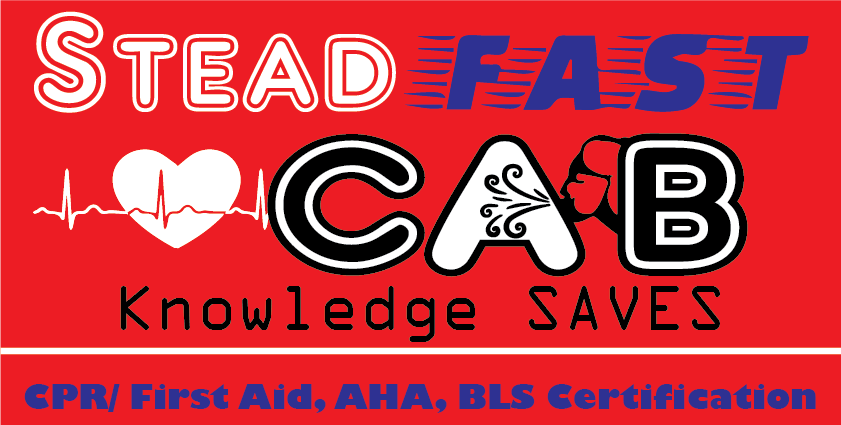Welcome to SteadFastCAB
Learn CPR and Save Lives
At SteadFastCAB, we empower you with the knowledge and skills to act swiftly and confidently during emergencies. Whether it's an adult, child, or infant in need, we provide comprehensive CPR training to equip you with life-saving techniques.

CPR
-

Adult CPR
1. Assess the Situation: Ensure the scene is safe, and check for responsiveness by tapping the victim's shoulder and shouting.
If unresponsive, call emergency services immediately. Send for AED if available
2. Perform HIGH QUALITY Chest Compressions:
Place the heel of one hand on the center of the victim's chest, then place the other hand on top.
Administer high-quality chest compressions at a rate of 100-120 per minute, ensuring adequate depth and recoil.
3. Provide Rescue Breaths: Deliver two breaths after every 30 compressions, ensuring proper head tilt and chin lift to maintain an open airway.
4. Continue CPR: Alternate between compressions and breaths until help arrives or the victim shows signs of recovery
• Use of AED:
Utilize an AED as soon as available, following voice prompts for effective defibrillation.
• Choking First Aid:
Apply abdominal thrusts to clear the airway obstruction if the victim is conscious and unable to breathe.
-

Child CPR
1. Assess the Situation: Ensure the scene is safe, and check for responsiveness by tapping the child's shoulder and shouting.
2. Perform Compressions: Adjust compression depth and hand placement for children, ensuring proper support and protection on the center of the child's chest, just below the nipple line. Push down about 1.5 inches at a rate of 100-120 compressions per minute.
3. Provide Rescue Breaths: Tilt the child's head back slightly, lift the chin, and give two breaths. Watch for chest rise.
4. Continue CPR: Keep alternating between compressions and breaths until help arrives or the child starts breathing.
• Two-Rescuer CPR: Coordinate with a partner for efficient chest compressions and rescue breaths, maintaining a ratio of 15:2.
• Choking First Aid:
Administer back blows and chest thrusts for choking children, alternating until the obstruction is dislodged.
-

Infant CPR
1. Check for Responsiveness: Gently tap the infant's foot and shout. Look for any signs of movement or responsiveness.
2. Perform Compressions: Use two-finger chest compressions and a smaller breath volume for infants, ensuring delicate care.
3. Provide Gentle Breaths: Cover the infant's mouth and nose with your mouth and give small puffs of air, watching for chest rise.
4. Continue CPR: Administer cycles of 30 compressions followed by two breaths until help arrives or the infant begins to breathe.
5. Two-Rescuer CPR: Coordinate with another rescuer for infant CPR, maintaining the ratio of 15:2 compressions to breaths.
• AED Application:
Use pediatric pads if available, following AED instructions for infants under one year old
• Choking First Aid:
Administer back blows and chest thrusts with a delicate touch, ensuring airway clearance without causing harm.
Why Choose SteadFastCAB?
·Expert Instruction: Our courses are led by certified instructors with extensive experience in CPR and first aid.
· Interactive Learning: Engage in hands-on training sessions and simulations to reinforce your skills.
·Certification: Receive nationally recognized certification upon successful completion of the course.
·Convenience: Flexible scheduling options are available.
Be Prepared. Be Confident. Learn CPR Today.
Knowledge Saves
Sign up for a course at SteadfastCAB and become a life-saving hero in your community.
Don't wait until it's too late – start your CPR training journey now.
